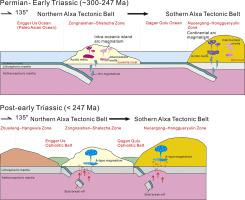Lithos ( IF 2.9 ) Pub Date : 2021-01-15 , DOI: 10.1016/j.lithos.2021.105980 Fenquan Xie , Jinghua Wu , Yonghe Sun , Lidong Wang , Jizhong Wu , Wenjuan Jia

|
The Alxa Tectonic Belt (ATB) is located in the southern Central Asian Orogenic Belt (CAOB), and its tectonic affinity and evolutionary history related to the closure of the Paleo-Asian Ocean are not fully understood. To refine our understanding of these issues, an investigation that includes petrographic observations, whole-rock geochemistry, zircon U Pb dating and Hf isotopic analyses was carried out on four felsic intrusions in the Zongnaishan–Shalazha Zone (ZSZ) and the Nuoergong–Honggueryulin Zone (NHZ) within this region. Despite their lithological differences, the four intrusions are identified as metaluminous, calc-alkaline to high-K calc-alkaline I-type granitoids that were derived from partial melting of heterogeneous crustal basement without significant fractional crystallization and crustal contamination. Zircon LA-ICP-MS U
Pb dating and Hf isotopic analyses was carried out on four felsic intrusions in the Zongnaishan–Shalazha Zone (ZSZ) and the Nuoergong–Honggueryulin Zone (NHZ) within this region. Despite their lithological differences, the four intrusions are identified as metaluminous, calc-alkaline to high-K calc-alkaline I-type granitoids that were derived from partial melting of heterogeneous crustal basement without significant fractional crystallization and crustal contamination. Zircon LA-ICP-MS U Pb dating results suggest that they were emplaced from the late Permian to the early Triassic (i.e., 247.7 ± 0.7 Ma for the Shalazha granite, 253.2 ± 0.9 Ma for the Shalazha granodiorite, 253.3 ± 0.6 Ma for the Nuoergong granite, and 251.6 ± 0.9 Ma for the Nuoergong tonalite). Geochemically, these granitoids show typical signatures of arc magma, such as enrichments in Rb, Th, K, and Pb, depletions in Zr, Nb, and Ta, and low Sr/Y and (La/Yb)N values. On tectonic discriminant diagrams, they plot in volcanic arc to post-collisional fields, indicating a tectonic transition from oceanic subduction to closure in the late Permian to early Triassic. Interestingly, granitoids from the ZSZ have positive εHf(t) values ranging from +1 to +7.9 with young two-stage crustal ages (TDMC) of 781–1209 Ma, in sharp contrast to the extremely negative εHf(t) values (−15.8 to −8.7) and old TDMC ages (1831–2272 Ma) of the granitoids in the NHZ. In addition, the zircon Hf isotopes of the ZSZ and NHZ granitoids show similarities to those of the magmatic rocks in the southern CAOB and western North China Craton, respectively, implying that the northern and southern ATB have different tectonic affinities. Thus, we propose that the Paleo-Asian Ocean lasted subduction in the late Permian and may close in the early Triassic, with subsequent accretion of the northern juvenile exotic microcontinent (ZSZ) to the southern old crustal basement (NHZ).
Pb dating results suggest that they were emplaced from the late Permian to the early Triassic (i.e., 247.7 ± 0.7 Ma for the Shalazha granite, 253.2 ± 0.9 Ma for the Shalazha granodiorite, 253.3 ± 0.6 Ma for the Nuoergong granite, and 251.6 ± 0.9 Ma for the Nuoergong tonalite). Geochemically, these granitoids show typical signatures of arc magma, such as enrichments in Rb, Th, K, and Pb, depletions in Zr, Nb, and Ta, and low Sr/Y and (La/Yb)N values. On tectonic discriminant diagrams, they plot in volcanic arc to post-collisional fields, indicating a tectonic transition from oceanic subduction to closure in the late Permian to early Triassic. Interestingly, granitoids from the ZSZ have positive εHf(t) values ranging from +1 to +7.9 with young two-stage crustal ages (TDMC) of 781–1209 Ma, in sharp contrast to the extremely negative εHf(t) values (−15.8 to −8.7) and old TDMC ages (1831–2272 Ma) of the granitoids in the NHZ. In addition, the zircon Hf isotopes of the ZSZ and NHZ granitoids show similarities to those of the magmatic rocks in the southern CAOB and western North China Craton, respectively, implying that the northern and southern ATB have different tectonic affinities. Thus, we propose that the Paleo-Asian Ocean lasted subduction in the late Permian and may close in the early Triassic, with subsequent accretion of the northern juvenile exotic microcontinent (ZSZ) to the southern old crustal basement (NHZ).











































 京公网安备 11010802027423号
京公网安备 11010802027423号